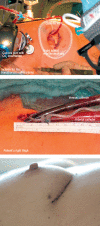Percutaneous and surgical treatment of mitral valve regurgitation
- PMID: 22211148
- PMCID: PMC3244168
- DOI: 10.3238/arztebl.2011.0816
Percutaneous and surgical treatment of mitral valve regurgitation
Abstract
Background: Mitral valve regurgitation is the second most common clinically relevant valvular heart disease in adults, with an incidence of about 2% to 3% per year. Surgical mitral valve repair is the treatment of choice. Recent years have seen major advances in minimally invasive mitral valve surgery. Several new catheter-based techniques are now being clinically evaluated, including percutaneous endovascular mitral valve repair with a mitral clip.
Method: This review is based on a selective review of the literature and on the authors' clinical experience.
Results: Minimally invasive and reconstructive techniques for mitral valve surgery have come into more common use in recent years. In Germany, more than 50% of all mitral valve defects are now treated with a valve-preserving repair procedure. At the same time, percutaneous techniques have been developed that enable reduction of mitral regurgitation in the cardiac catheterization laboratory, without surgery. The implantation of a mitral clip is the sole currently approved technique of this type. In a recently published, randomized comparative clinical trial (EVEREST II), it was found to be safer, but less effective, than surgery.
Conclusion: Mitral valve surgery remains the treatment of choice for severe mitral regurgitation. For patients at high risk from surgery, and particularly those with severe heart failure, the implantation of a mitral clip is a safe and feasible treatment option.
Figures


References
-
- Freed LA, et al. Prevalence and clinical outcome of mitral-valve prolapse. N Engl J Med. 1999;341:1–7. - PubMed
-
- Devereux RB, et al. Prevalence and correlates of mitral valve prolapse in a population-based sample of American Indians: the Strong Heart Study. Am J Med. 2001;111:679–685. - PubMed
-
- Enriquez-Sarano M, et al. Quantitative determinants of the outcome of asymptomatic mitral regurgitation. N Engl J Med. 2005;352:875–883. - PubMed
-
- Seeburger J, et al. Minimal invasive mitral valve repair for mitral regurgitation: results of 1339 consecutive patients. Eur J Cardiothorac Surg. 2008;34:760–765. - PubMed
Publication types
MeSH terms
LinkOut - more resources
Full Text Sources
Medical

